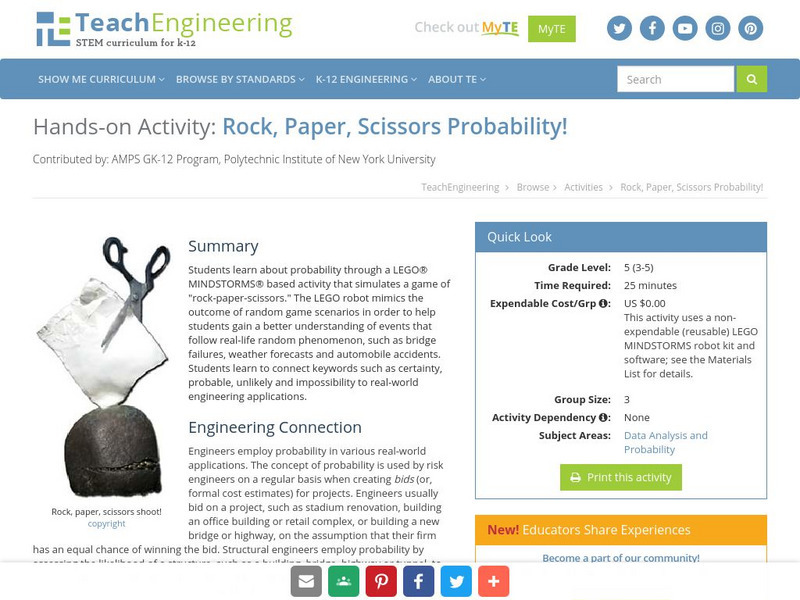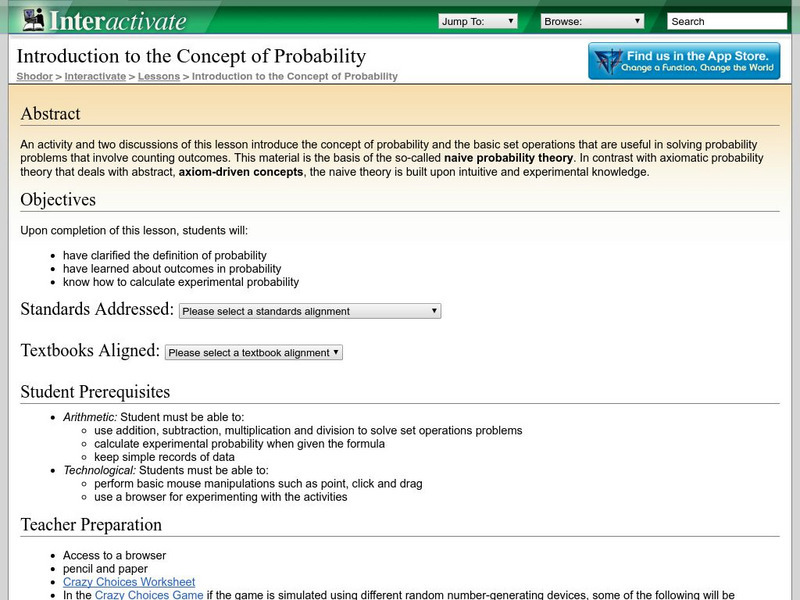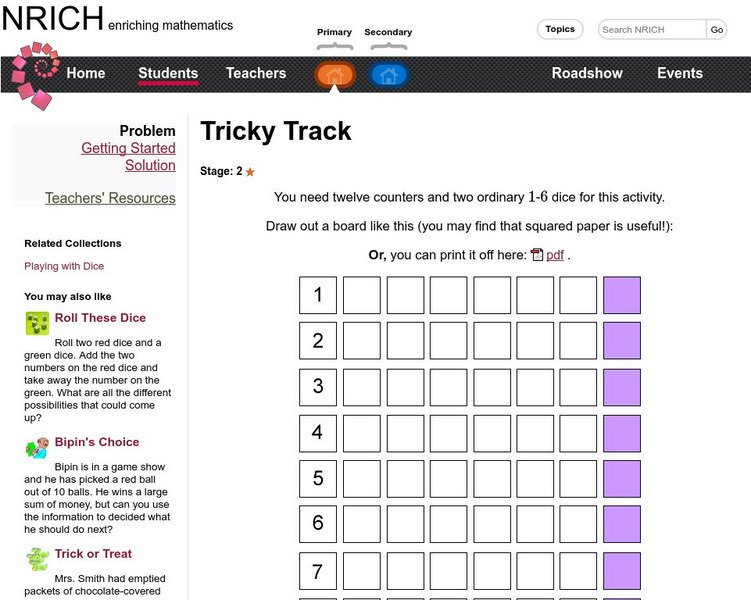Hi, what do you want to do?
Curated OER
Practice Interview Questions
The class is learning about jobs and interviewing, but you'd like to coach them a bit more. Great! Here are a set of interview questions that include teacher notes you can use to help learners understand how to answer each question to...
Curated OER
Problem Solving Strategy: Use Models: Problem Solving
In this probability worksheet, students use math models and the problem solving strategy of understand, plan, solve, and look back to help them complete the two probability questions.
Curated OER
You May Already Be a Winner!
Second graders flip coins and tally the outcomes. They play the You May Already Be a Winner! game with cards under their chairs. Some cards are winners, some might be and the others are not. They play to explain the probability concept.
Curated OER
A Statistical Study on the Letters of the Alphabet
Students see that there are mathematical rules that can affect our use of the English language. Calculate the probability of picking any letter at random from a piece of English literature.
Curated OER
Heads & Tails Data Collection
For this data collection worksheet, students use a penny and a dime to play a math game. Students flip the money in the cup and then record the number of heads and tails showing marking the coins in the box.
Curated OER
Monty's Dilemma
In this algebra worksheet, students are asked to choose a door and decide whether they should keep it or not after they are shown what is behind one of the doors. This worksheet is based on probability. There are 3 questions with an...
Curated OER
Simulation and Statistics
Students perform simulation of video games as they explore statistics. In this algebra instructional activity, students relate concepts of statistics and data collection to solve problems. They decide their next step based on the...
Curated OER
Who Does the Lottery Benefit?
Students investigate the pros and cons of the lottery. In this algebra instructional activity, students use the formulas for permutation and combination to test their arguments about the lottery. They collect data about their argument...
Curated OER
Combination Vs. Permutation
In this probability worksheet, students analyze word problems, determine whether the situation is a combination or a permutation, and solve. There are 5 multiple choice questions.
Curated OER
Animals in the Wild
Students explore the role of snakes in an ecosystem and discover how snakes warn us that they are dangerous. They view and discuss a Discovery Channel video showcasing snakes in the wild then break into small groups to research a...
Curated OER
Coin Shake-Up
Students discuss problem and take turns in pairs, one tossing the coins while the other guesses whether the coins land with the same side up or different sides up. They record the results of each guess as same or different.
Curated OER
Can You Do This?
Third graders write paragraphs describing activities for classmates to perform using toys such as balls, jump ropes or hula hoops. They take turns reading their paragraphs while other students follow the directions.
National Council of Teachers of Mathematics
Nctm: Illuminations: The Game of Skunk
This is a great math game for students to gain an understanding of experimental probability.
TeachEngineering
Teach Engineering: Rock, Paper, Scissors Probability!
Students learn about probability through a LEGO MINDSTORMS NTX-based activity that simulates a game of "rock-paper-scissors." The LEGO robot mimics the outcome of random game scenarios in order to help students gain a better...
University of Cambridge
University of Cambridge: Nrich: Game Do You Measure Up?
This interactive game gives you a variety of measuring tools and measuring opportunity. For this game of chance you choose the correct tool for the job that needs to be measured. Everything you need for this game is listed and/or...
National Council of Teachers of Mathematics
Nctm: Figure This: Wheel of Fortune's Frequent Letters
Did you know that letter guessing on Wheel of Fortune is based on probability? In this challenge taken from one of TV's most popular game shows, discover what consonant or vowel should be guessed next based on letters already given. A...
Other
The Actuarial Foundation: Are You Game? [Pdf]
Games are designed to help learners understand and apply concepts of probability. determine fairness.
Shodor Education Foundation
Shodor Interactivate: Lesson: Intro to the Concept of Probability
The Shodor Education Foundation provides this lesson plan to introduce students to the concepts of probability. Students learn about the definition of, outcomes in, and calculations of experimental probability. Students use an...
University of Cambridge
University of Cambridge: Nrich: Tricky Track Game
The directions on this site are for an interesting, two-player dice game named Tricky Track. Grab a partner and play. Do your results surprise you?
US Department of Education
Nces: Kids' Zone: Chances
Dice game allows you to see how increasing or decreasing the number of dice rolls affects an outcome.
PBS
Pbs Learning Media: The Squares Game
In this video segment from "Cyberchase", the CyberSquad determines the fairness of a game in which there are three shapes distributed equally on nine squares. Uses popups, two minutes and 13 seconds.
PBS
Pbs: The Lowdown: Your Odds of Winning Powerball: Probabilities of Compound Events Using Visuals
In this video, explore the odds of winning the Powerball lottery and learn what few people realize about their chances of winning: they are miniscule. In the accompanying classroom activity, students create simple lottery models to help...
National Council of Teachers of Mathematics
Nctm: Figure This: Who Wins the Game?
A math challenge for the basketball enthusiast. This NCTM Math Challenges for Families activity focuses on the concept of probability. Test your problem solving aptitude as you try to figure out who will probably win the game.
PBS
Pbs Learning Media: Hacker's Four Zergen Game
In this video segment from Cyberchase, the CyberSquad determines the fairness of a game in which there are three shapes distributed equally on nine squares.























